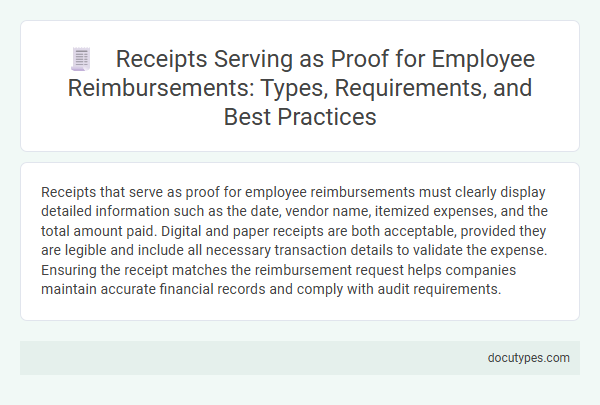Receipts that serve as proof for employee reimbursements must clearly display detailed information such as the date, vendor name, itemized expenses, and the total amount paid. Digital and paper receipts are both acceptable, provided they are legible and include all necessary transaction details to validate the expense. Ensuring the receipt matches the reimbursement request helps companies maintain accurate financial records and comply with audit requirements.
Introduction to Receipts in Employee Reimbursements
Receipts are essential documents that validate expenses for employee reimbursements. They provide evidence that expenditure was made for business purposes.
- Original Receipts - Physical or digital copies of receipts issued at the point of sale serve as primary proof of purchases.
- Itemized Receipts - Detailed receipts listing each purchased item help verify the exact nature and amount of expenses.
- Official Invoices - Invoices from vendors or service providers can qualify as valid proof when they include payment confirmation.
Your reimbursement claims should be supported by appropriate receipts to ensure accuracy and compliance with company policies.
Importance of Receipts as Proof of Expenses
Receipts serve as essential proof for employee reimbursements by documenting the exact amount spent and validating the legitimacy of the expense. Clear, itemized receipts help employers verify that purchases comply with company policies and IRS regulations. You should always retain receipts to ensure a smooth reimbursement process and accurate financial record-keeping.
Types of Receipts Commonly Accepted for Reimbursements
Receipts play a crucial role in validating expenses for employee reimbursements. Clear documentation ensures your claims are processed efficiently and accurately.
- Itemized Receipts - These receipts detail individual items purchased, providing transparency for expense verification.
- Credit Card Statements - Often accepted when accompanied by detailed descriptions, these statements support proof of payment.
- Hotel and Travel Invoices - Official invoices from lodging or transportation services demonstrate legitimate business expenses.
Essential Information Required on Receipts
Receipts that serve as proof for employee reimbursements must contain essential information to validate expenses. Key details include the date of the transaction, vendor's name, and a clear description of the purchased items or services.
The receipt should also display the total amount paid and the payment method used. Without these critical elements, reimbursement claims may be delayed or denied by finance departments.
Digital vs. Physical Receipts: Pros and Cons
| Receipt Type | Definition | Advantages | Disadvantages |
|---|---|---|---|
| Physical Receipts | Paper copies provided at the point of sale to document transactions. |
|
|
| Digital Receipts | Electronic records of transactions, often emailed or accessible via apps. |
|
|
Receipt Submission Requirements for Employees
Receipts serve as essential proof for employee reimbursements by validating expenses incurred during official business activities. Only itemized receipts that clearly show the date, vendor, and amount spent qualify for submission.
Employees must submit original, legible receipts promptly to comply with company reimbursement policies. Digital copies or scanned images are acceptable when originals are unavailable, provided all necessary details remain visible.
Common Challenges with Receipts in Reimbursement Processes
Which receipts serve as valid proof for employee reimbursements? Receipts that clearly display the date, merchant name, itemized purchases, and total amount are typically accepted. These documents ensure transparency and accountability in the reimbursement process.
What are common challenges with receipts in reimbursement processes? Receipts can often be lost, illegible, or lack necessary details, creating delays and disputes in approval. These issues complicate verification and increase administrative workload for finance teams.
How can you improve receipt handling for employee reimbursements? Implementing digital receipt capture and standardized submission guidelines reduces errors and streamlines processing. This approach helps maintain accurate records and speeds up reimbursement timelines.
Best Practices for Receiving and Storing Receipts
Receipts that include detailed information such as the date, vendor name, items purchased, and total amount serve as valid proof for employee reimbursements. Clear and legible receipts help ensure accurate expense tracking and facilitate smooth reimbursement processes.
Best practices for receiving receipts involve requesting original, itemized receipts immediately after transactions. Employees should verify that all necessary details are present before submitting for reimbursement. For storing receipts, digital scanning and organizing receipts in categorized folders enhance accessibility and reduce the risk of loss or damage.
Auditing and Verifying Employee Receipts
Receipts that serve as proof for employee reimbursements typically include detailed vendor information, purchase dates, and itemized expenses. During auditing and verifying employee receipts, it is essential to ensure that each receipt matches the claimed amount and complies with company policies. You should retain original or digital copies of receipts to facilitate accurate reimbursement processing and financial accountability.
Which Receipts Serve as Proof for Employee Reimbursements? Infographic

